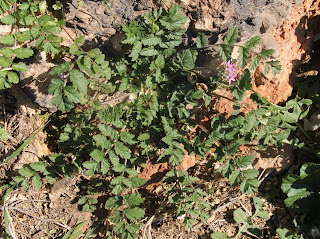On flowers, cameras, travels, friends and other marvels of nature
Saturday, March 31, 2012
Friday, March 30, 2012
Hyacinthus orientalis
Peplos, Thrace, Mars 28, 2012
Hyacinthus orientalis originates in southern and central Turkey, northern Syria and Israel, from where it was introduced to Europe in early modernity. It is often cultivated, but it occurs in wild form as well. The main difference between the cultivar and the natural plant is the number of flowers per spike. On the cultivar they may range from 40 to 100, while on the natural plant (as the one on the pictures above) they are usually less than 15. According to Greek mythology Hyacinthe was a beautifull young lover of Apollo, who, when killed accidentally, was transformed by the god to the namebearing flower. The sources are numerous: Homer, Iliad ii.595-600; Apollodorus, Library 1.3.3; Ovid, Metamorphoses 10. 162-219; Pausanias, Description of Greece 3.1.3, 3.19.4; Philostratus the Elder, Images i.24; Philostratus the Younger, Images 14; Lucian, Dialogues of the Gods 14. However, the plant described by Theophrastus, History of Plants 6.6.10, under the name of hyakinthos, is not the one we call nowadays by the same name. It was probably some species of iris.
Narcissus pseudonarcissus ssp. obvallaris
Peplos, Thrace, Mars 28, 2012
Narcissus pseudonarcissus ssp. obvallaris, commonly called Tenby daffodil, is a cultivar, which now grows wild in some areas of northern Greece, as the above speciment found on grassland near the village Peplos, in the Evros district. This particular subspecies happens to be widely cultivated in the gardens of the village.
Thursday, March 29, 2012
Dimorphoteca ecklonis (Cape marguerite)
Philopappos hill, Athens, Mars 3, 2012
Dimorphoteca ecklonis is a native plant of South Africa (hence its common name: Cape marguerite), which has been introduced to Greece as an ornamental one. It seems however very well acclimatized and it grows wild in the vicinity of gardens, from which it escaped.
Sunday, March 18, 2012
Helleborus cyclophyllus
Mt. Chortiatis, Macedonia, February 25, 2012
This is the only species of the genus Helleborus, which extends today to the Central Greece. The ancient sources, however, refer to Helleborus niger (ελλέβορος μέλας) as growing on Oeta, Parnassus and Helicon mountains, and been used by the ancient Greeks as a cure for epilepsy, melancholy and madness (Theophrastus, HP ΙΧ 2, 8.8, 10.2-4. Dioscorides, De materia medica IV 148-152, 162. Strabo ΙΧ 418. Pausanias Χ 37, 7-8. Horace, Sermones II 1. 83, 166; Ars Poetica 300. Pliny, HN XXV 47-52. Suetonius, De Vita Caesarum: Caius Caligula XXIX. Petronius, Satiricon 88, 4. Aulus Gellius, Noctes Atticae XVII 15. 1, 6. Valerius Maximus, VIII 7 fragm. 5. Frontinus, Strategemata III 7,6. Polyaenus, VI 13). Since Helleborus niger has never been reported in modern time Greece, it is quite possible that the species called today by this name is not identical with the "Helleborus niger" of the ancients. In this case Helleborus cyclophyllus (modern Greek name: σκάρφη) would be the most probable candidate to identify with the ελλέβορος μέλας of the ancient sources.
Stellaria cupanii
Corfu, Mars 13, 2012
The Stellaria cupanii is sometimes treated as a subspecies of Stellaria media. There are however several differences, among which the most visible is the number of stamens (always 10 in cupanii; often less, between 3 and 7, in media). Stellaria cupanii is also often confused with Stellaria neglecta; the later however has a single row of hairs on the stem, while the former has the stem uniformely covered with hairs.
Saturday, March 17, 2012
Crocus chrysanthus (snow crocus)
Mt. Chortiatis, Macedonia, February 25, 2012
On a sunny Saturday of February we decided with my friend Yannis V. to walk from the village Chortiatis to the mountain shelter, a distance of 2.5 - 3 hours. The mount kept in some places much of the snow fallen in previews weeks. The Crocus bloomed just next to the snow cape. On the thrid and fourth pictures you may observe a rare specimen with 8, instead of usual 6, petals.
Lunaria annua
Corfu, Mars 13, 2012
Lunaria annua is commonly known as "Silver dollar" or "Chinese money" because of the shape and colour of its seeds. It is also known as "Corfu blue" because it is widespread on the island of Corfu , in the Ionian Sea . The pictures above are taken precisely in Corfu (Kerkyra), in a warm spring afternoon, during a visit to the island with my colleague and friend Yorgos T.
We both had to give lectures in a master class of History and Digital resources and while Yorgos was teaching and I was waiting my turn, I used the opportunity to walk around the so-called New Fortress of the city. I have been pleasantly surprised by the variety and rarity of the wild flowers I encountered, among which the Lunaria here above.
Subscribe to:
Posts (Atom)



